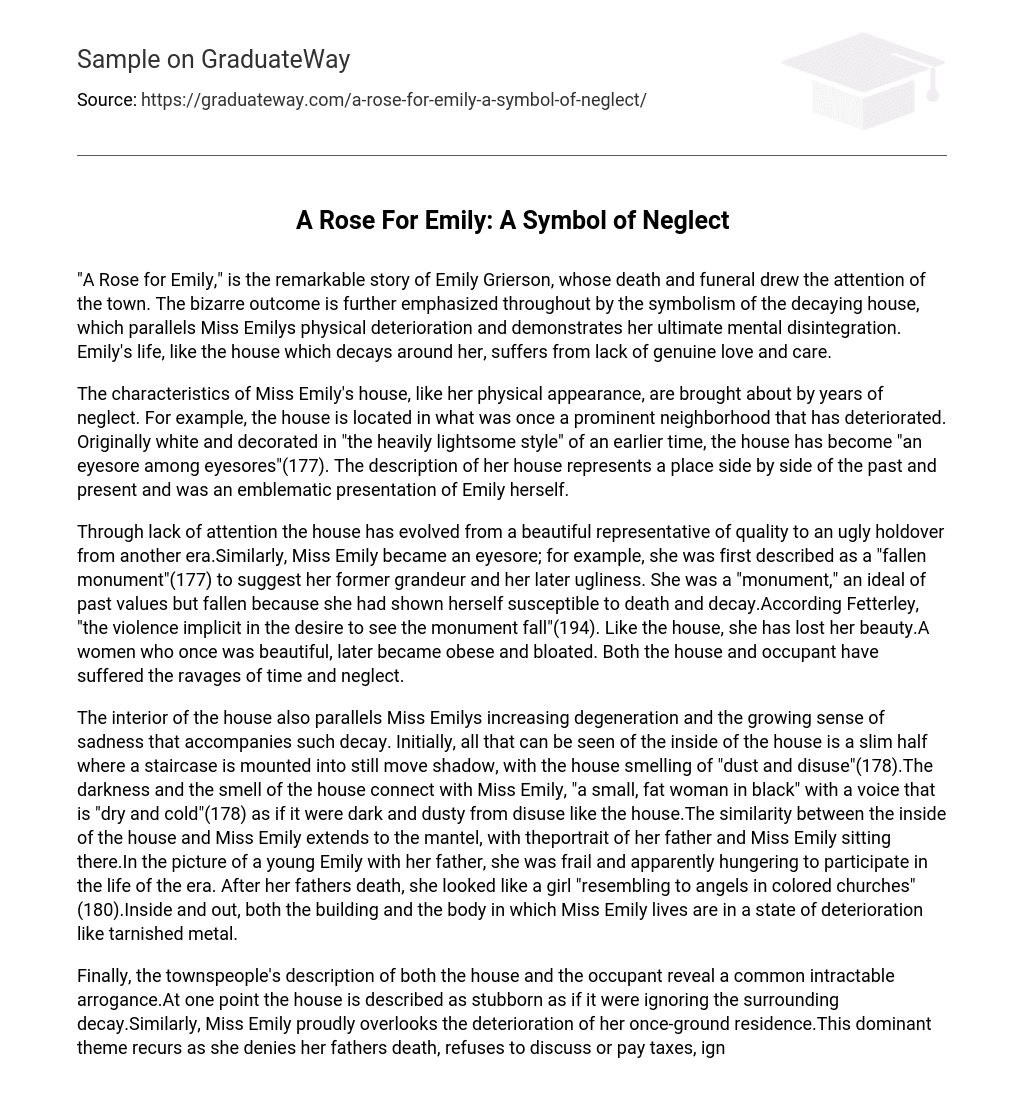“A Rose for Emily” is the astonishing tale of Emily Grierson, a woman whose death and funeral captured the town’s attention. The peculiar result is highlighted by the symbolism of the decaying house, mirroring Miss Emily’s physical decline and showcasing her eventual mental breakdown. Similar to the deteriorating house, Emily’s life is plagued by a lack of authentic affection and nurturing.
Miss Emily’s house, similar to her physical appearance, has been influenced by years of neglect. The house is situated in a neighborhood that was once prominent but has since deteriorated. Although it was originally white and adorned with the elegant style of an earlier era, the house now stands out as an unattractive sight amidst a degraded environment (177). This portrayal of her house symbolizes the coexistence of the past and present and serves as a representative depiction of Emily herself.
The house has transformed from an exquisite representation of quality to an unsightly remainder from a different era due to negligence. Similarly, Miss Emily has become an eyesore. She was initially described as a “fallen monument” (177), highlighting her former greatness and subsequent unattractiveness. She was an embodiment of past values, but her vulnerability to death and decay caused her fall from grace. According to Fetterley, there is an inherent violence in the desire to witness the downfall of a monument (194). Like the house, she has lost her beauty. A once beautiful woman now endures obesity and bloating. Both the house and its inhabitant have endured the detrimental effects of time and disregard.
The house’s interior reflects Miss Emily’s deteriorating state and the accompanying sense of sadness. Initially, only a narrow staircase in shadow, emitting the scent of “dust and disuse,” is visible (178). This darkness and smell mirror Miss Emily, who is described as a “small, fat woman in black” with a “dry and cold” voice (178). The likeness between the house’s interior and Miss Emily extends to the mantel, where her father’s portrait sits alongside her. In the picture, a young Emily appears frail and yearning for involvement in the era’s life. Following her father’s death, she resembles “angels in colored churches” (180). Both the building and Miss Emily’s body are deteriorating, akin to tarnished metal.
Both the house and Miss Emily exhibit an unyielding arrogance, as described by the townspeople. The house is stubborn and disregards the decay around it, while Miss Emily proudly ignores the deterioration of her once-grand residence. This prevalent theme is manifested in various actions: denying her father’s death, refusing to address or pay taxes, disregarding rumors of her promiscuity, and withholding the reason for purchasing arsenic from the druggist. According to Brooks, Miss Emily may be considered crazy, but she is not afraid of what others think of her. Both the house and Miss Emily become traps for Homer Barron, a laborer and confirmed bachelor who represents the spirit of the twentieth century. For Blythe, Homer is characterized as Miss Emily’s gay beau. Like the house, Emily resists progress and modernization until they both become obsolete relics.
The text highlights the parallel between the deteriorating house and Miss Emily Grierson in “A Rose for Emily.” Both the house and Miss Emily suffer from neglect and lack of love, leading to their physical and emotional decay. Over the course of forty years, the once beautiful and elegant house transforms into an ugly state, mirroring Miss Emily’s own deteriorating condition. The source for this analysis is Cleanth Brooks’ “On A Rose for Emily” in Literature for Composition, edited by Sylan Barnet, et al., 4th edition, published by HaperCollins in 1995 (190-1).
Blythe, Hal. “Faulkner’s A Rose for Emily.” Barnet. 192-3.
Fetterley, Judith. “A Rose for Emily A Rose for Emily.” Barnet. 194-96





